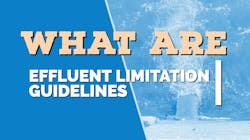Effluent guidelines are developed by the EPA for effluents discharged by various industrial operations. Also known as the EPA effluent limitation guidelines, they are regulatory standards and they apply to industrial wastewater discharges to surface water and to publicly owned treatment works (POTWs) including municipal sewage treatment plants.
What is the purpose of the EPA Effluent Guidelines?
EPA effluent guidelines are standards developed with the overall aim to help direct and indirect dischargers reduce the discharge of regulated pollutants into receiving waters. This is done using treatment and control technologies identified by EPA.
The EPA effluent guidelines are not based on risk studies or impact studies for the regulated pollutants. Rather, they are technology-based which means they are based on the performance of treatment and control technologies for specific regulated pollutants.
Three types of regulated pollutants
There are three types of regulated pollutants: conventional, toxic, and non-conventional pollutants. Conventional pollutants are listed in 40 CFR §401.16 and also include oil and grease. Those not categorized as conventional are nonconventional pollutants.
Both conventional and non-conventional regulated pollutants include toxic pollutants. Per- and polyfluorinated substances (PFAS) are examples of toxic pollutants in the non-conventional pollutants category.
Some of the toxic pollutants among conventional regulated pollutants are priority pollutants and a list of these are available in 40 CFR Part 423, Appendix A. As of June 2023, there are 129 priority pollutants and these include phthalates used in plastic products. All the three types of pollutants are regulated by different control technologies.
The six control technologies in the EPA effluent guidelines
There are six control technologies for regulated pollutants in the EPA effluent guidelines: best available technology (BAT), best practicable control technology (BPT), best conventional pollutant control technology (BCT), New Source Performance Standards (NSPS), Pretreatment Standards for Existing Sources (PSES), and Pretreatment Standards for New Sources (PSNS).
The prior four (BAT, BPT, BCT, and NSPS) are applicable to direct dischargers while PSES and PSNS are applicable to indirect dischargers. Although BPT and NSPS are applicable to all three types of pollutants (conventional, non-conventional, and priority pollutants), the other control technologies are applicable to some of these pollutants.
How are the Effluent Limitation Guidelines developed?
There are several steps taken by EPA to develop these guidelines:
- Gathering information on industry practices and characteristics of discharges, including the identification of regulated pollutants present in the discharges, the technologies or practices available to prevent or to treat the discharges, and the expense of using the technologies.
- Using the information from above, EPA identifies the control technology that is economically suitable for the particular industry to prevent or treat the regulated pollutant(s) in the discharge.
- Based on the performance of the selected technology from above, EPA sets regulatory standards (i.e. effluent guidelines) for the regulated pollutant(s) in the discharge.
The aim of these steps is to reduce the level of the regulated pollutant(s) in the receiving waters so as to reduce their toxic effects on wastewater treatment operations and environmental health. Although all the applicable control technologies are considered and the selection is based on economic suitability, there are other factors considered by the EPA in the selection of the control technology.
For example, NSPS are the most stringent control technologies and to consider these, in addition to considering the cost for achieving the reduction in the level of the regulated pollutant, EPA also considers the energy requirements according to the Clean Water Act (CWA).
Similarly to consider BPT, in addition to the cost and the energy requirements, EPA also considers the age of the equipment and the facilities, the processes employed, and the engineering aspects of the BPT control technologies.
To consider BCTs, EPA looks into the performance of the POTW and the costs associated with it. These examples show the multitude of factors that the EPA considers when selecting a suitable control technology.
Enforcement of the numeric limits
In order to enforce a numeric limit on a regulated pollutant, approved analytical methods are carried out. These are specified in the comprehensive list of tables and associated methods in 40 CFR Part 136.
For example, Table IB contains tests for inorganic pollutants and Table IG contains tests for pesticide active ingredients. Part 136 also contains comprehensive information on quality control and specific methods such as Method 200.7 for determining metals and trace elements in water using inductively coupled plasma-atomic emission spectrometry.
How are the effluent limitation guidelines implemented?
The implementation is done under specific programs depending on whether the discharge is direct or indirect and the receiving source of the discharge. The National Pollutant Discharge Elimination System (NPDES) program applies to direct dischargers to a water body and the pretreatment program applies to indirect discharges to a municipal sewage treatment plant.
Tracking compliance
The following are databases to track compliance:
- Discharge Monitoring Report (DMR) Pollutant Loading Tool: This database provides information on who is discharging, how much, and to where. It uses data from ICIS-NPDES.
- Integrated Compliance Information System (ICIS)-NPDES: This is a database to track compliance for the facilities regulated by the NPDES. It provides information on the permit facility, the fluent violation, and the enforcement actions.
- Information from these databases is also used by the Enforcement and Compliance History Online (ECHO) system.
Effluent guidelines programs
EPA regularly reviews the effluent guidelines and updates them to address current challenges with regulated pollutants in wastewater discharges.
Effluent Guidelines Program Plan 15
The latest update for effluent guidelines was published in January 2023, called the Effluent Guidelines Program Plan 15 which also focuses on the EPA’s 2021 PFAS Strategic Roadmap. It includes updates on the on-going rule-making to revise the effluent limitation guidelines for PFAS in wastewater discharges for Organic, Chemical, Plastics, and Synthetic Fibers Point Source Category.
Pollutants discharged into wastewater are regulated by the CWA. EPA, to enforce the regulation of these discharged pollutants, approves analytical methods to detect these pollutants and also develops effluent limitation guidelines by taking control technologies into consideration.
The overall aim of the effluent limitation guidelines, i.e. the national regulatory standards for wastewater discharged to surface water and to municipal sewage treatment plants, is not only to protect environmental health, but to also enforce discharge permits and to protect the infrastructures of the POTWs.
About the Author
Saleha Kuzniewski
Saleha Kuzniewski, Ph.D. has authored several publications in the fields of scientific research, biotechnology, and environmental regulations. She is the winner of the 2023 Apex award for publication excellence. She is also the founder of Environmental Remediation & Innovations, LLC. Kuzniewski can be reached at [email protected].

